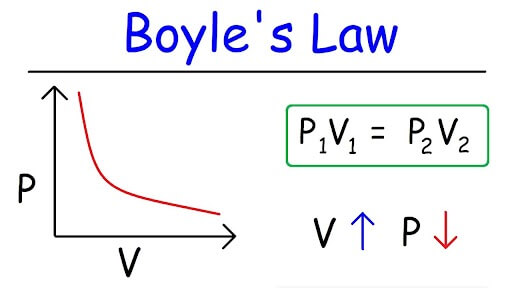Boyle's Law
Boyle's Law: You would have studied the working of the respiratory system in the human body. This system of breathing could be well explained on the basis of Boyle's law. This law helps to explain how the lung volume may be increased or decreased which thereby causes a relatively lower or higher air pressure within them. This forms a pressure difference between the air inside the lungs and the environmental air pressure, causing either inhalation or exhalation as air moves from high to low pressure.
What is Boyle's Law?
This concept of Boyle's law was first time put forward by Anglo-chemist Robert Boyle in the year 1662. Boyle's law which is also called Boyle–Mariotte law, or Mariotte's law, states that “the pressure exerted by a gas on any given mass, kept at a constant temperature is inversely proportional to the volume occupied by it”. In other words, we can say that Pressure is inversely proportional to the volume where the temperature is kept constant.
Formula and Derivation of Boyle's Law
On the basis of Boyle's experiments, the conclusion is that at a constant temperature, the pressure of a fixed amount of gas is inversely proportional to its volume. This is known as Boyle’s law. Mathematically, it can be said as-
P ∝ 1/V
P =K1/V
K = PV
Where,
K is the proportionality constant
P is the pressure exerted by the gas
V is the Volume occupied by the container.
If a fixed amount of gas at constant temperature T occupying volume V1 at pressure P1 undergoes expansion, so that volume becomes V2 and pressure becomes P2, then according to Boyle’s law :
P1V1 = P2V2 = Constant
P1/P2 = V2/V1
Where,
P1 is the initial pressure exerted by the gas or pressure exerted before expansion
P2 is the final pressure exerted by the gas or pressure exerted after expansion.
V1 is the initial volume occupied by the container or before expansion
V2 is the final volume occupied by the container or volume after expansion.

Application of Boyle's Law
Spray bottle: Spray paint or aerosol spray is considered one of the applications of Boyle’s law, as it is generally based on Boyle’s law, where the paint container contains two substances, one is the paint material itself, and the other is a compressed gas which is in liquid state in the container. As soon the sprayer is pressed and the gas starts to come out of the container, the liquefied gas starts to expand and turns itself into gas, and the gas presses the paint inside the container. The paint material is pushed up to get out of the sprayer nozzle with gas escaping from the container.
Soad bottle: Soda bottles or cans are considered a real-life application of Boyle’s law. When you open the soda bottle, you are actually reducing the pressure on the gas, and the volume of the gas starts to expand. In this case, when the cap begins to open, the gas from the soda bottle tries to escape. But, because of being intermixed with the liquid, the gas brings the fluid with it and they are pushed out together, turning into foam.
Diving into the deep Water: Every expert diver knows that, after diving in deep water, divers have to return to the top very slowly. The reason for this is that our bodies are built and designed to live under natural pressure. As the diver moves down to the deep waters, the pressure increases. As we know increased pressure leads to a decrease in volume, and the diver’s blood begins to absorb the nitrogen gas. If the diver makes a slow rise, the nitrogen gas molecules expand and return to normal without any problem but if it rises quickly, the diver’s blood turns into foam.
Exercise Based on Boyle's Law
The solved exercise based on Boyle's law is-
Q1.A balloon is filled with hydrogen at room temperature. It will burst if pressure exceeds 0.4 bar. If at 1 bar pressure the gas occupies 4.27 L volume, up to what volume can the balloon be expanded?
Solution: According to Boyle’s Law P1V1 = P2V2
According to the question, at P1 = 1bar the V1 is 4.27L
And, P2 = 0.4 bar the V2 is P1V1/P2
V2 = 1 x 4.27/0.4
V2 = 10.67L
Q2. A sample of air has a volume of 500dm³ and a pressure of 1 bar. What additional pressure is required to reduce the volume to 200 dm³ at 30° C?
Solution: Initial Pressure = 1 bar
Initial Volume = 500dm³
Final Volume = 200 dm³
Final Pressure =?
According to Boyle’s Law P1V1 = P2V2
P2 = P1V1/V2
P2 = 1x 500/200
P2 = 2.5 bar
So the additional pressure required is = 2.5 - 1.0 = 1.5 bar
| Related Links- |
| Newton's Law of Motion |
